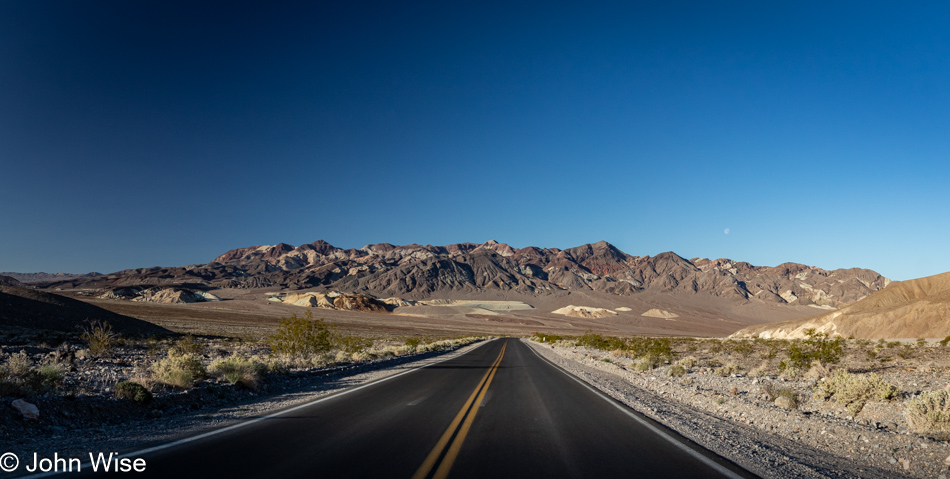
Being on a mini-vacation could be the opportunity to take it easy, right? Wrong, we were up by 5:30. Just as we were about to leave the Inn, Caroline took the opportunity to WhatsApp family in Germany who’d assembled for Easter dinner. However, out here in Shoshone, California, the connection is less than optimal, and the call brief. I am able to use the short delay to jot down a few things, and then we’re on our way towards Death Valley for a hike before things get too busy over there, and we need to head home to Phoenix.

The Death Valley Coyote Committee fell short, with only a single member showing up to greet us, can you tell that this otherwise wild animal has grown accustomed to approaching cars up at the main entrance to the park for meal handouts?

There’s no time to spare if we are going to get on the Golden Canyon Trail this morning, and knowing that the first part of this 5.5-mile hike draws a big crowd, we opted to head into Golden Canyon first, which would have us taking the trail we are ultimately interested in clockwise. You see, Golden Canyon is just one small part of our intended hike; our main objective is the Gower Gulch Loop Trail with a detour to the Red Cathedral. After being shocked by the crowds at Badwater yesterday, this location was running a close second for pulling in throngs of visitors. We knew that if we were going to enjoy this trail, we’d have to arrive before the masses overwhelmed the parking area with overflow parking ending up on the main road.

Our faulty memories initially thought we’d hiked this short segment with my mother-in-law Jutta, but as we got further into Golden Canyon, we realized that we’d likely never been here before, and we were well aware that even this assessment might be wrong. I could scour our previous seven visits to Death Valley to verify things, but how many hundreds, if not thousands, of photos would I have to check? As I finished writing that question, my curiosity got the best of me, and it turns out that I have over 2,000 photos that have been properly tagged with the words “Death Valley,” and I only had to scroll forward to 2008 to find that we were indeed in this canyon on a previous visit. Taken on a beautiful February late afternoon were photos of Caroline and her mom walking in a very empty Golden Canyon that we apparently had all to ourselves. Sometimes, I think things are changing in ways I don’t like, and I tend to attribute my disdain for those changes to those of a man growing grumpy and looking at the past through those proverbial rose-colored glasses, but by judging by those old photos, I see that, in fact, this national park has grown busier.

Fortunately, we are still able to find moments when we are seemingly alone and must offer gratitude that we’ve had so many previous opportunities to visit, oblivious that within little more than a dozen years, the number of people in the parks would go so high that it would interfere with our memories of what solitude meant to us and how we were able to experience it on those earlier encounters. I can’t write this without thinking that Caroline and I need to make every effort to revisit our favorite places yet again before the next burst of visitation threatens to put everything on a reservation or lottery system.
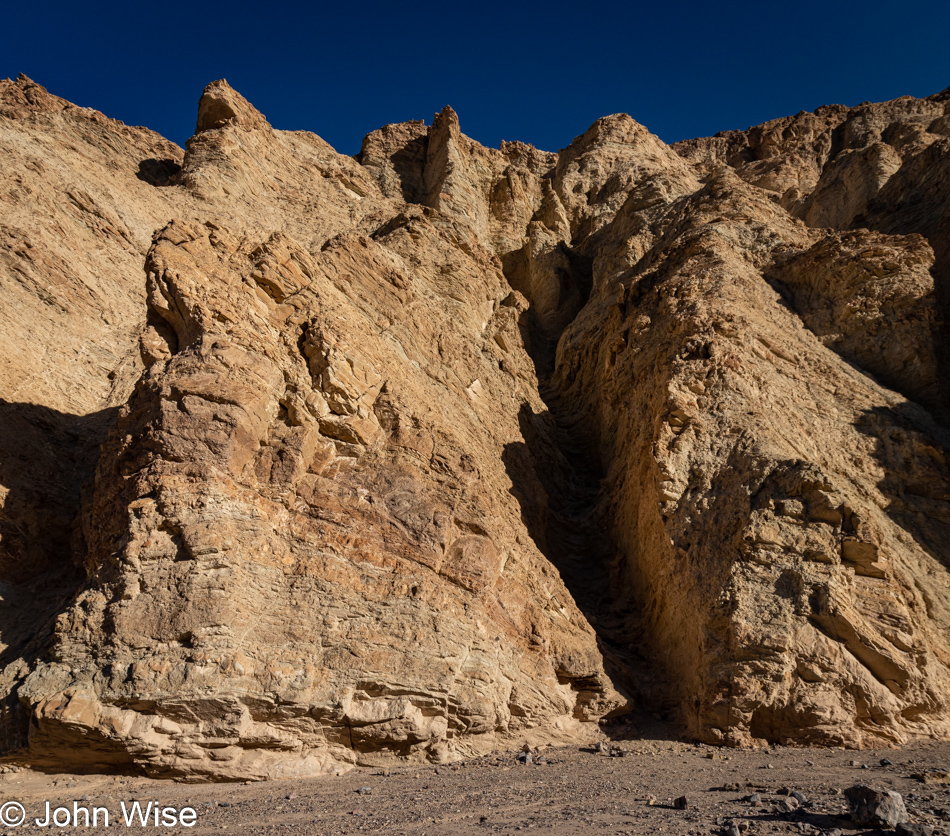
What I couldn’t really identify in my photos from 2008 was exactly how far we trekked into this canyon, but it wasn’t likely very far. My mother-in-law in tow wasn’t one with big stamina, and making surface impressions was certainly enough for her. That really means that this was all new to us, and what’s better than getting to experience something for the first time twice in a lifetime?

Our previous encounter with Golden Canyon was at 5:00 in the afternoon, while we arrived today before 8:00 in the morning hence, the shadows are falling in very different patterns. This triggers the thought that I should collect earlier photos before leaving for these trips and have them on hand so I can compare what we see with shots I took years prior and try to take them again, but what would really make that work is if I’d taken notes about the conditions regarding visitors and then I could contrast the experience from a decade or two earlier with today.
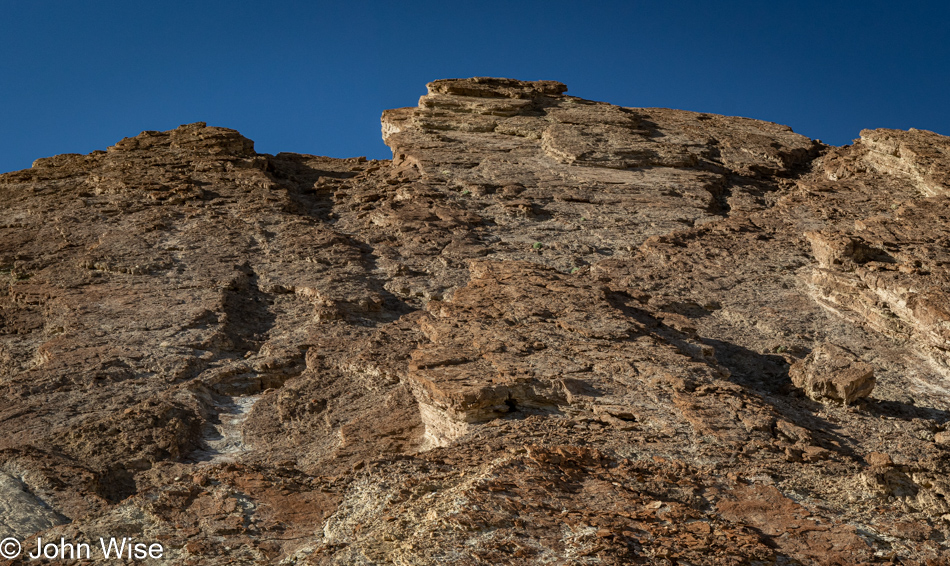
I’ve stared at these rocks a good long time trying to understand the erosion patterns. To my eye, it looks like this was uplifted just yesterday, and the sharp edges formed while it was lying down are yet to be worn down. Knowing that this wasn’t thrust into this angle in the past month, let alone a few hundred years, only adds to the mystery surrounding time and how much of it must pass before things start to appear familiar as far as eroding mountains are concerned.

To suggest that there is art here seems to imply that the rest of nature might be devoid of it; on the contrary, art is in everything and everywhere. In researching for this post, I came across a photo of the nearby Manly Beacon taken by Ansel Adams back in the 1940s, and now I’m looking at my own stuff through the filter of someone who made a serious craft of capturing the western United States, but I’m me, and this is the best I can do, and I can take great solace in knowing that I’m trying to express myself.

We think this is the Red Cathedral, and while we’ll get closer, there never was a sign pointing to a specific spot letting us know that this was it.

This, though, is Manly Beacon and that we are certain of.

That’s Telescope Peak over there.

This is Caroline Wise over here, near the end of this part of the trail. Time to connect with the Gower Gulch Loop Trail.
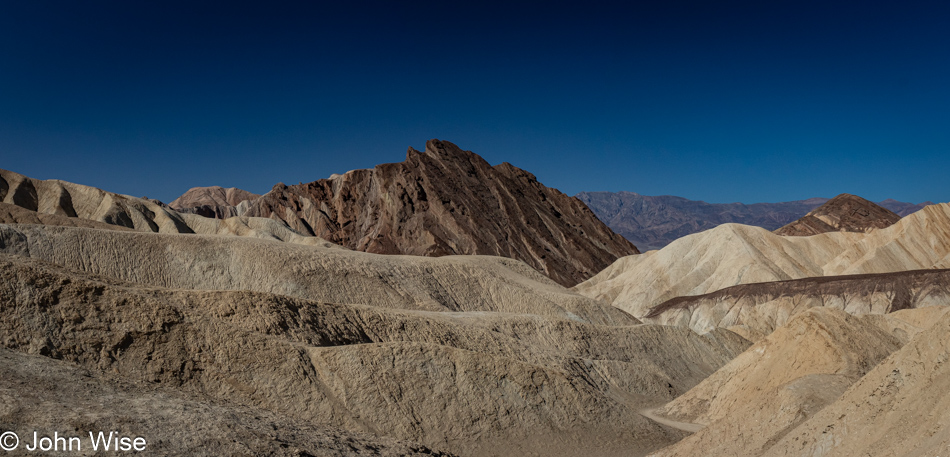
The first part of this trail is a bit steep, which is great with views such as this.

I’ve spotted something ahead, and it’s not the sun that is making me nervous over at the foot of Manly.
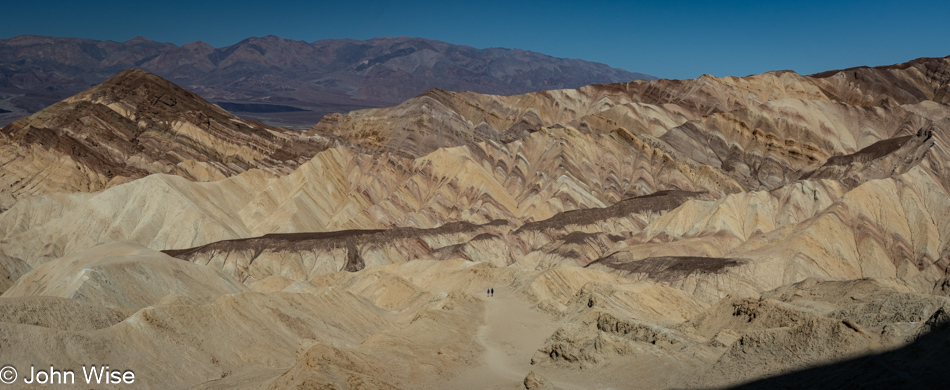
First, though we must go higher as everything changes perspective depending on from what distance you are looking at a thing. If you look at the center of the trail we are slogging up, you’ll see a couple who, in passing, told me not to worry a bit and that the object of my concern shouldn’t be one. That’s a relief.
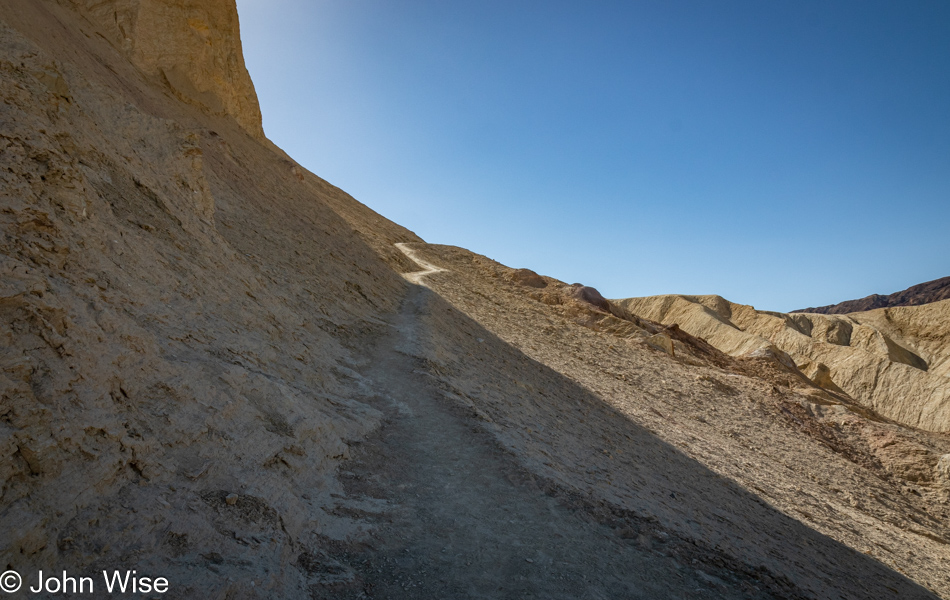
That was until I got up on the razor’s edge, where my imagination of imminent doom stole any confidence I might have been trying to bring forward. My knees buckled, and I knew this was the end of the trail for me. I think it’s high time for me to get those trekking poles I’ve considered to give me a bit more stability and something to lean on in these situations or simply accept that I could crawl on my hands and knees to the other side. But no matter today, as panic set in and in an instant, we were on our way back down to the place whence we came.

I’m trying hard here to put on a brave face because I’m seriously and, to my core, disappointed in what I cannot do. While we’ll have accumulated 27 miles of walking and hiking over the long weekend, these turnarounds slap hard at what I want to accomplish, and it’s not just me here; I know for certain that Caroline, too, wants to see what’s out there on the other side of the trail we’ve never experienced. So, I try to suck down the pride and giant sense of failure before putting on a grimace of a smile to say to myself, “It’s okay; we can’t do everything in life we might want to do.” And anyway, we are doing a lot and know that, but still, it’s bittersweet.

Exiting the canyon, we encountered a lot more people, which was exactly what we hoped to miss by taking the Gowers Gulch trail, but looking on the bright side, finishing our time early in Death Valley means we’ll be getting home earlier than we might have otherwise.
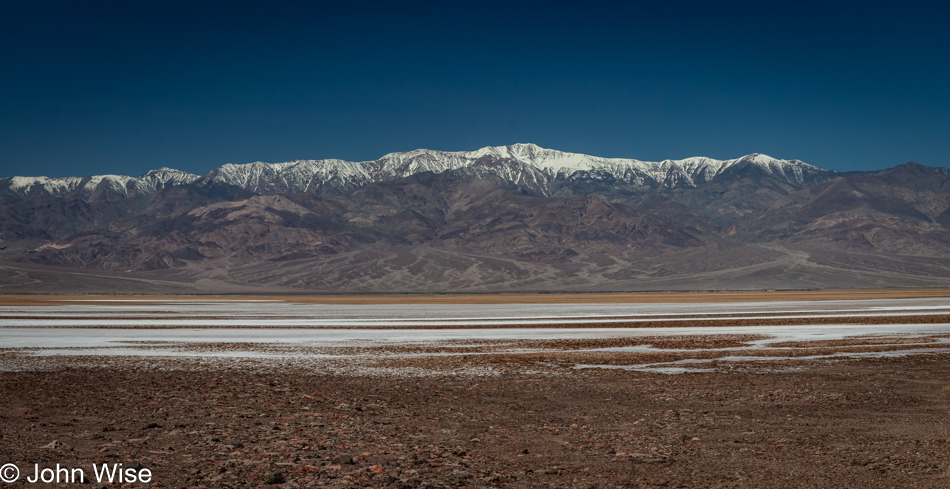
Unless we end up stopping at a bunch of other places because we think we’re so early.

Good thing we felt flexible with our time because while out exploring one of a few areas of the saltpan, we were able to catch sight of these very fine and fragile salt filaments, which ChatGPT informed me are quite rare.
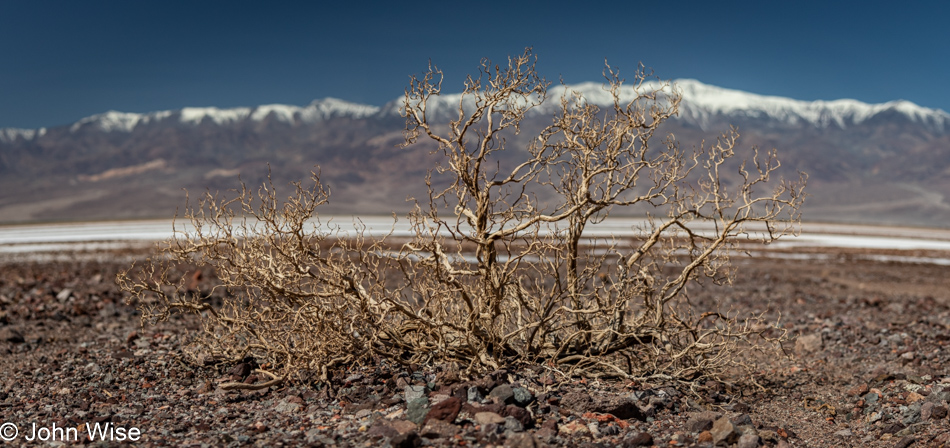
In a landscape with so few large plants, a dried-up old bush skeleton stands in stark relief of the vast space where little else interrupts the eye.

Could it be that on our way into the park/life, we take things for granted as we aim for the places that will bring glory and a sense of accomplishment, and then on the way out, we grow fearful that we’ve missed many important sites due to our myopia of not always seeing what seems to have been right in front of our faces. Looking at this rock formation, one might suddenly capture the essence of Death Valley held right here, but on closer examination have second thoughts that it holds so much relevancy. When departing places/life, moments of recognizing small details you missed take on greater significance, and possibly a little panic seeps into those fleeting thoughts, triggering you to gaze deeper. This is one of those instances.

Salt and mud crusts such as these are part of where the Devils Golf Course further north takes its name. These hard and very resilient jagged surfaces rise up over the underlying mud during wet periods, and if I were a geologist or could find a really knowledgeable source who could explain the precise action, I’d share more, but I’m coming up empty.
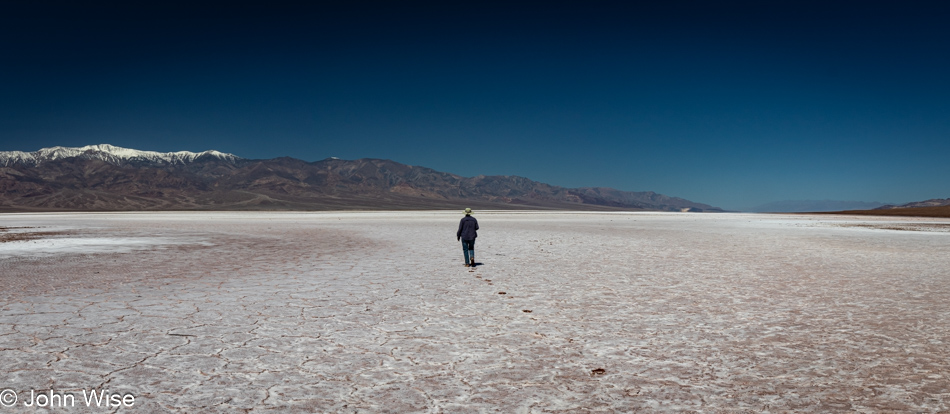
My fingers hover over the keyboard as I’m reminiscing how our feet are occasionally sinking and slipping in the mud out here. Gazing at that image, I’m trying to find something to say that speaks louder than the poetry of being out in the middle of a place where one can sense isolation and quiet that lingers in the small corners of the soul for a longer time than the body was present. It’s funny how people want to visit other planets when similar experiences can be had in so many places right here on the earth we live on but see so little of. We have the opportunity to walk on the surface of a sphere hurtling through space that has been evolving for billions of years to get most everything right before our arrival, and we’re already bored of it and fantasize about going to Mars so we take a photo of someone walking across its landscape with an exclamation of, “Wow, we did it.” Meanwhile, on our own space-traveling outpost, we can’t make the effort to realize the perfection we exist in every day.
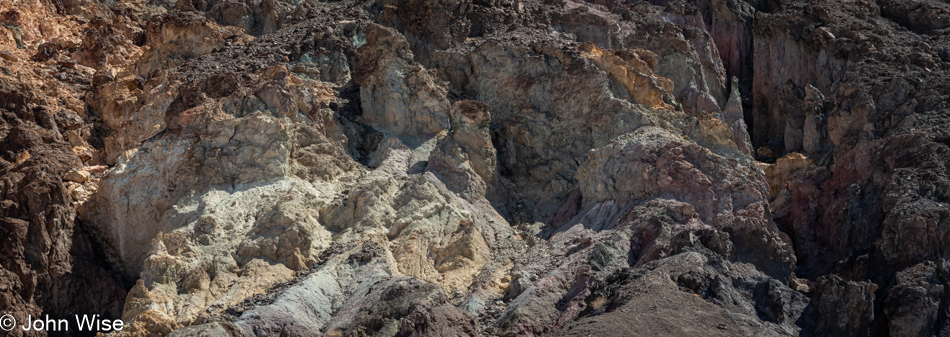
Right here might be some of the precursors of the macro-minerals we are made of, including calcium, phosphorus, potassium, sodium, chloride, magnesium, and sulfur. There might also be some of the 16 trace minerals: iron, zinc, copper, manganese, iodine, selenium, fluoride, molybdenum, boron, cobalt, nickel, vanadium, silicon, strontium, chromium, and bromine. Finally, there are other trace minerals whose role in our bodies we are still trying to figure out, such as arsenic, aluminum, barium, beryllium, bromine, cadmium, chromium, cobalt, gallium, germanium, gold, lithium, nickel, palladium, platinum, rubidium, silver, strontium, tellurium, thallium, tin, titanium, tungsten, vanadium, and zirconium. What I’m pointing out is that we consider life to be living beings (like ourselves), but without the rocks that become soil, the plants and animals that nourish other things wouldn’t have been able to give rise to us.

At first glance, I thought this was sulfur, but on reflection, I remember we didn’t smell anything that would have confirmed that. Limonite is yellow, so maybe that’s what we are looking at. Whatever it was, it was attractive enough for me to stop yet again on this trek to leave Death Valley.
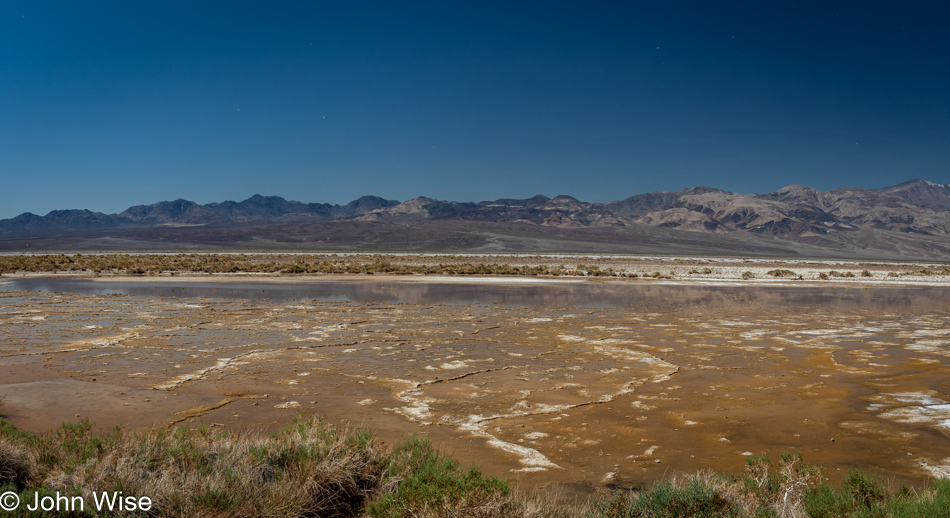
I referenced the minerals that make up the human body and how we consume them from the food we eat, but the really big deal is that we are 65% water and oxygen. So, if you consider a 150-pound (68kg) person, 98 pounds (44kg) of their weight is in the form of water and oxygen. But wait, there’s more! This part might have you thinking I’m stoned as I write this, but I had never considered that when we look at H2O, it is the oxygen that makes up 89% of its weight. While this may be basic chemistry to everyone else, this is the first time I learned of this. So tell me again, why does a creature that is so reliant on soil, oxygen, and water desire to try living on a planet that is mostly dry, has only trace amounts of oxygen, and the dirt is called regolith, which means it is not soil and will need considerable work to become useful for growing food? The only answer I can come up with is that it is easier to distract people with fantastic dreams of leaving our earth instead of trying to live on it and care for it. And somehow, we believe we can make another (extremely inhospitable) planet habitable. We must be insane.
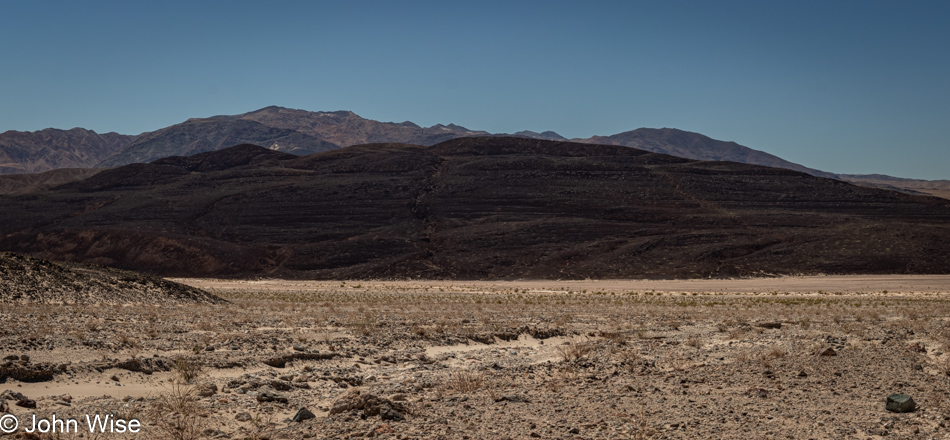
A fading sign caught my eye, necessitating a quick backup to pull over and read what I thought I had. Sure enough, those horizontal edges are remnants of shorelines from Lake Manly on what was at one time an island. We should have noticed this before as we’ve seen similar features in the Yukon, Canada, where a backed-up Alsek River flooded a valley nearly all the way to Haines Junction, leaving similar shoreline markings on nearby mountainsides. This rather large, still-visible detail allows us to easily imagine the 100-mile, 600-foot deep lake that stretched from here to points north. Just one more instance of not being able to see what’s in front of you due to a lack of knowledge or not knowing where to look.

For years Caroline has been looking for a Neopolitan ice cream sandwich as she finds the plain old vanilla to be boring. Well, we finally found one here in Baker, California, and still, she’s not happy on two counts. First, the version in Germany she grew up with uses waffles for the outside instead of the sticky chocolate cake-like stuff we are accustomed to in America. Second, she realized that if the flavors were distributed using the length of the sandwich, she’d be able to enjoy all three flavors at once.

Ivanpah Solar Electric Generating System or Thermal Plant is the world’s largest bird roaster. The atmospheric glare is extraordinary to witness as we approach the (miniscule) town of Nipton, California. It’s obvious that there’s a bizarre amount of ambient light illuminating the air being reflected and directed from the strategically angled mirrors. After getting home, I was looking to learn something or other about this peculiar sight, and in one particular article, they talked of the 900-degree (482c) instant-combustion beam that has smoking birds plummeting to earth roasted if they get to close to the bad hot place. This has me thinking that these thermal plants might be avian hell because, for a bird that is innocently out and about in their normally supportive bird environment, things become instantly torturous as the sky aims to cook them alive in a blindingly fast millisecond.

Seems like it was only ten years ago that my hair was hardly gray, and now, in the right light, it looks like I have a personal thermal plant perched upon my head.

Whoa, how have we missed this Joshua tree forest out here? It turns out that we’ve not previously driven Highway 164, a.k.a. Nipton Road, and so we knew nothing of the Wee Thump Joshua Tree Wilderness. The words Wee Thump mean “ancient ones” in the Paiute language. This is the third largest Joshua tree forest on earth, as in the entire earth, and we’ve now seen these giants with our very own eyes.

And not only that, they are in bloom. We cannot say we’ve ever seen Joshua trees in bloom, so we’ll go with this being a first. In that sense, come to think of it, this is like an Easter egg, well for me at least. I’ll explain that comment in just a sec.

Not one to miss abandoned roadside America, this old “Fresh Produce” sign seemingly held fast by the saguaro was a site that needed recording. We are passing through Wikieup north of Nothing and only about 120 miles from home at this point, and it was here that Caroline found her Easter egg.

Happy Easter, Caroline! Yet another dental floss pick, an Easter egg of the best kind. You see, Caroline had been haunted by these stupid little things and sees them everywhere. They pop into her view all the time, to the point that she’s considering getting a task-specific pair of tweezers and a plastic bag that she carries with her to collect these bits of trash used in the hygiene of caring for one’s mouth. Why they seem to be so widely distributed is a mystery, but maybe if she starts documenting their location and picking up these discarded tools, she can start to identify what they have in common or if there is a pattern on the map that might become apparent. While they are something absurd to be consumed by, their vexing ubiquity found strewn across the landscape is likely creating a bit of neurosis for my wife. Does anyone know of a lost dental floss pick support group she can join?